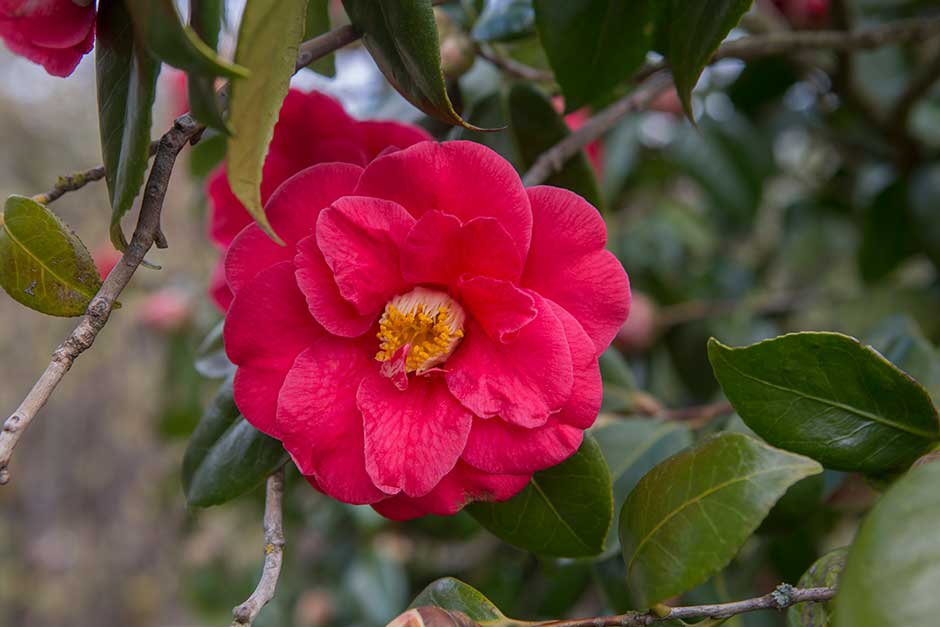People have liked camellias for thousands of years. They liked them so much that they were planted in the gardens of aristocrats and allowed to decorate the grounds of old temples, where Shinto gods were thought to live among the flowers.
Because they have been in love for so long, these plants have been bred and crossed, and now there are thousands of known varieties. When you plant a camellia, you’re not only adding beauty to your garden, but history as well.
We link to vendors to help you find relevant products. If you buy from one of our links, we may earn a commission.
There are numerous reasons that you might want to duplicate your camellia plant. Perhaps you’re interested in starting a tea garden, and you want to use your healthy C. sinensis plant to parent several more, increasing your harvest of leaves.
You might have a beautiful plant whose name you can’t remember or that came with the house you bought and want to plant more of the same kind.
For example, you might want to make a flowering privacy hedge with the same type of plant but don’t want to spend a lot of money on new plants.
Whatever the reason, you can easily propagate more camellias by yourself, at home, from a healthy specimen. But how will you choose which method to use? Let’s talk about that!.
Camellias are beautiful flowering shrubs that can add charm and color to any garden. With their glossy leaves and stunning blooms, camellias are a joy to grow However, buying new camellia plants for your garden can get expensive A great way to get new camellia plants for free is by rooting cuttings from existing plants. Rooting camellia cuttings is an easy process that anyone can do at home with minimal equipment. In this article, you’ll learn the step-by-step process for rooting camellia cuttings successfully.
Overview of Rooting Camellia Cuttings
Rooting camellia cuttings involves taking a cutting from a “mother plant”, placing it in rooting medium, and providing the right conditions for roots to form. This allows you to propagate new camellia plants that are genetically identical clones of the mother plant for free.
The basic steps are:
- Take 3-4 inch tip cuttings from healthy camellia plants in early summer. Make angled slice on stem end.
- Wound the stem by making a shallow cut to expose the cambium layer.
- Dip cutting in rooting hormone (optional but boosts success rate).
- Stick cutting in moist rooting medium like perlite, vermiculite, peat moss.
- Place in warm area with high humidity and indirect sunlight.
- Keep medium moist until roots form in 4-8 weeks.
- Transplant rooted cuttings into pots with potting mix.
Follow these steps properly and you’ll have young camellia clones ready to add to your garden!
Selecting the Mother Plant
The first step is choosing a suitable mother plant to take your cutting from Pick a healthy camellia plant that is at least 2-3 years old, Avoid taking cuttings from weak or diseased plants,
Ideally, select a plant that has desirable traits you wish to replicate. Your new clones will be identical to the parent. So if the mother plant produces abundant flowers, has lustrous leaves, or another prized attribute, your cuttings will too!
Take cuttings in early to mid summer when plants are actively growing. This timing gives cuttings the best chance to form roots.
Preparing the Cutting
Once you’ve identified a good mother plant, the next step is taking and preparing the cutting. Follow these tips:
- Use a sharp, sterile pruning shear or knife to prevent damage.
- Take 3-4 inch long tip cuttings from current season’s growth.
- Cut just below a leaf node where leaves emerge from stems.
- Remove all but two leaves at the top to reduce moisture loss.
- Make a angled slice at the stem base which exposes more surface area.
- Wound the stem by making a 1 inch shallow cut on one side to expose the cambium layer inside. This helps prompt root growth.
You can dip the bare stem end in rooting hormone powder/gel to further spur root production. While not essential, studies show applying rooting hormone boosts success rate significantly.
Providing the Rooting Medium
To grow roots, your cutting needs the right rooting medium. This provides moisture, nutrients, and support.
Many gardeners use perlite or vermiculite as an easy medium to start. To prepare:
- Fill a 3-4 inch deep container with coarse perlite/vermiculite.
- Water thoroughly until damp but not soggy.
You can also use a soilless potting mix, peat moss, or coarse sand. The key is a loose, well-draining medium that retains moisture but won’t stay wet.
Moisten your rooting medium before inserting cuttings. It should feel like a wrung out sponge – moist but not dripping wet.
Inserting and Caring for Cuttings
Now you’re ready to stick the cutting into the medium! Follow these tips for this important step:
- Make a hole in the rooting medium with pencil about 2 inches deep.
- Carefully insert the wounded stem end into the hole. Make sure it’s touching the rooting medium.
- Firm the medium gently around the stem. Leave about 1-2 inches of stem exposed.
- Water gently to moisten again after inserting cuttings.
- Place container in a warm area with high humidity and indirect light.
- Cover with plastic wrap or bag to maintain humidity if needed.
Adequate warmth and humidity is key for promoting root growth. Ideal conditions are 65-75°F and 60%+ humidity. A bright window or greenhouse provide good environments.
Keep the medium consistently moist but not saturated. Water when the top inch becomes dry. Proper moisture is vital for new roots to develop.
Change the plastic cover or bag daily to allow fresh air exchange and prevent fungal issues.
Root Development
Within 4-8 weeks, your cuttings should have grown new root systems. You can gently tug on cuttings to test for resistance that indicates root formation.
When roots are 1-2 inches long, the cutting is ready to be potted up. Carefully remove from rooting medium and transplant into a 3-4 inch pot with moist potting mix.
Keep newly potted cuttings sheltered for 1-2 weeks to reduce transplant shock. Then begin acclimating them to normal outdoor conditions. Gradually increase sun exposure and reduce watering frequency.
In no time at all your cuttings will grow into mature, blooming camellia plants ready for your garden!
Troubleshooting Common Issues
Sometimes cuttings fail to form roots and die off. This often results from improper care. Here are some common issues and solutions:
-
Rotting stem: Caused by overwatering. Allow medium to dry out between waterings. Increase air circulation.
-
Drying out: Too little moisture causes shriveled, brown leaves. Water more frequently to keep evenly moist.
-
Leaves dropping: Dry air or transplant shock is the culprit. Mist leaves, improve humidity, or re-cut stems.
-
No roots: Low temperatures or inadequate humidity prevents root growth. Move to warmer area, cover container, or use bottom heat.
-
Leggy growth: Too much light results in excessive top growth without roots. Provide bright, indirect light instead of full sun.
Adjust care accordingly if you notice any of these problems. With the right conditions and care, your camellia cuttings will thrive!
Enjoying Your Rooted Cuttings
The great thing about propagating camellias from cuttings is that you end up with plants genetically identical to the mother. This means you know exactly the variety you’re getting and can replicate prized plant characteristics.
Within a year, your rooted cuttings will grow into attractive camellia plants ready to beautify your garden. They make great gifts for fellow gardening friends too.
Camellias demand minimal care once established. They thrive with partial shade, moderate watering, and yearly mulching. Light pruning after flowering maintains an shapely form.
So unlock the versatility of your existing camellias by rooting cuttings. With simple homemade propagation, you can expand your garden collection with endless camellia varieties for free!
Which Method Is Best?
The method you should use to propagate your camellia plant depends on the result you hope to achieve. Some methods will produce better results than others.
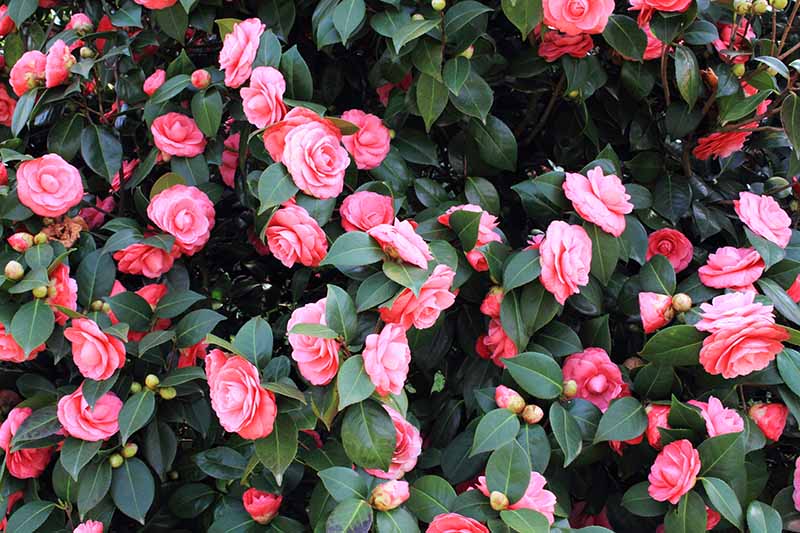
Since they have been crossedbred for thousands of years, starting from seeds is not the best way to make a copy of a certain plant.
Camellias grown from seeds often have flowers or leaves that are different from the parent plant, or they may grow in a very different way. Resulting plants can also be infertile and may fail to bloom.
Plant growers generally prefer to propagate camellias through grafting. This is the process of putting a cutting from a plant with the traits you want next to root stock of a hardy variety and letting them grow together.
It is very common to graft camellias, roses, and fruit trees because these plants have unique traits that growers like to pass on, like certain flower shapes, colors, or fruit.
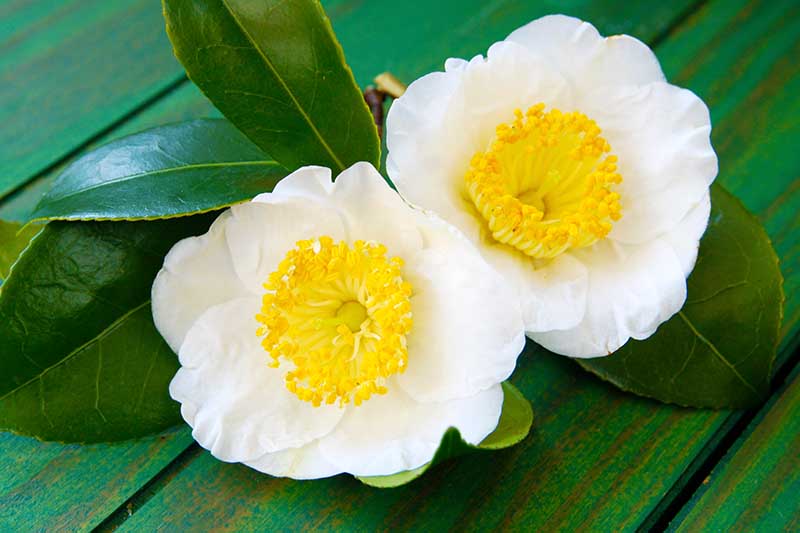
Sometimes, even on a more mature shrub, you can tell if it was grown by grafting by looking for callusing. More mature plant grafts may no longer be identifiable.
You may be able to see a section of the trunk that has a clear ridge or raised “seam” where the scion, or cutting from a parent plant, was joined to the root stock. This is usually just above ground level.
Rooting cuttings, grafting, layering, or air layering are also the best ways to grow grafted plants because they keep the most of the parent plant’s traits.
So, where do we begin? Let’s take a look at the six top methods next.
There are quite a few methods of propagation out there in the plant world.
For our purposes, we will only look at tried-and-true methods that are known to work best for camellias.
These six methods are used by plant nurseries, commercial growers, and home gardeners alike.
If you want to grow plants that look exactly like the parent, like for a uniform hedge, you might want to try one of the other methods below.
But if you just want to try growing a camellia from a seed and don’t care about getting the same traits as the parent plant, this is a good place to start.
In fact, many of the varieties we have now were created from plants that were grown from seeds, which led to very different results. Camellia seeds present potentially infinite possibilities. What mystery does that little seed hold?.
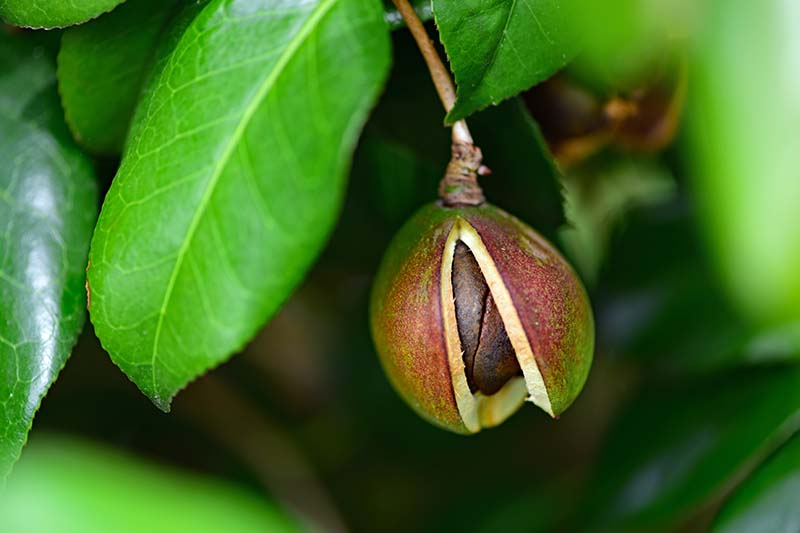
You may see round, green seed pods on the branches in late winter and early spring, after the flowers have died back for the season. Each pod is about the size of a large grape or a small apricot.
The pods will start to form after flowers have been pollinated. By fall or winter, they may turn darker and split open, showing dark brown to black seeds inside.
Remember that seeds from different species are different sizes and colors, and they all ripen at different times.
Pods of the C. japonica species tend to ripen sooner than those of other species, sometimes in mid to late summer.
Do not open the pods before they split on their own, or the seeds inside will not grow. If you don’t want the seeds to fall out when the pods open, wrap a piece of pantyhose or garden cloth around the pod loosely to catch them.
Another method of passive harvesting is to use mesh barrier bags to catch seeds in your absence, such as these, available from Amazon.
Once the pods start to split open on their own, you might need to break or cut off some of the outer shell to get all the seeds out.
Over time, this will happen naturally, but there’s no harm in helping them along after seeds are ripe.
Harvest seeds and immediately prepare them for planting by scarifying the seed coat. Use something rough, like sandpaper, to rub the seed, or use a sharp knife to make a small nick in the seed coat.
Scarifying can aid in water absorption, which may speed up germination. Scarified seeds should be soaked in warm water for about twelve hours. If seeds dry out, they may lose viability.
Seeds should be planted as soon as possible after being harvested. If you can’t, put them in a plastic bag with some wet peat moss and put it in the fridge until you’re ready to plant them.
Observe that each seed has an “eye,” or a small depression, on one end. Because the root will grow here, you need to plant the seed so that the eye faces down.
A mix of one part soil or compost, one part peat moss, and one part silica sand or perlite should be used for planting.
Plant seeds half an inch deep in starter cells and water well. Keep soil slightly damp, but not wet, while you wait for germination.
Place pots in a warm area. A lidded plastic storage tote can be used, acting as a greenhouse to provide optimum sprouting conditions.
A seed starting tray with a lid works as well, and you can find them at Home Depot.
Once the seedlings have come up, make sure they get eight to ten hours of indirect sunlight every day. Also, keep the soil moist but not wet.
Alternatively, seeds can be direct-sown at the planting site.
Discover how to pick the best spot for your camellias and take good care of them by reading our guide. Seeds that are direct-sown may not germinate until spring.
After the seedlings have grown their first true leaves, you can move them from their pot to their new home.
If you want to grow camellias in pots, carefully take the seedling out of the pot and shake off the soil to get to the roots. Take pruning shears and cut off the end of the taproot. This is the longest and thickest root in the plants.
Cutting the taproot will help the root ball get denser and more fibrous, which is better for growing in pots.
You can grow more camellias by rooting stem cuttings, which is also a good way to grow other broadleaf shrubs like roses or azaleas. Taking cuttings is the fastest method of propagation.
One part potting soil or compost and one part perlite or coarse silica sand should be mixed together to make potting medium.
You can start each cutting in its own pot or put several in a larger pot as long as there is at least two inches of space between them. Containers should be four to six inches deep to allow space for the roots to develop.
Cut a branch from the existing camellia that shows new growth, which is typically present in early spring. New growth roots more easily than cuttings taken from dormant plants.
Cut the side branches away from the main branch between the main branch and the first leaf node. You should have a few stems that are about four inches long and have at least a few leaves on each one.
Remove the lower leaves so only the two leaves at the end of the stem remain. To help the cuttings grow roots, dip the cut end in rooting hormone powder and push them two to three inches into drainage medium.
You don’t need to press down on the planting medium like you would with a seed or a seedling that has been moved, because rooting works better in loose soil. Mist with water to dampen.
Put the cuttings in pots in a clear plastic storage bag with a lid. Keep the bag in a warm place that gets indirect sunlight. As an alternative, you could use a greenhouse or a warm, damp spot that is protected and gets a lot of sun.
If you want to keep heat and moisture in, you can also wrap each cutting and pot in its own plastic bag and seal it tightly.
Check for moisture daily and mist with water if the planting medium feels dry. Cuttings that dry out will most likely not take root.
It can take two to three months for roots to develop. See if the first bud starts to form on each cutting. This means the plants are starting to grow roots.
Despite your best efforts, it’s possible that some cuttings may not take root. When buds appear, carefully take plants out of the pot and put them in separate 8- or 10-inch pots with the potting mix that was suggested above.
Growth is a good sign that the cuttings are establishing themselves, which means they’re rooting and getting water and food on their own.
Once the plants have grown new leaves and their roots have reached the edge of the pot, they can be moved one last time to their permanent home.
If plants are going to be grown in pots, remember to cut off the end of the taproot with garden shears.
The root system will become more fibrous and wide when the taproot is cut. It will need less depth than if it were growing in the ground.
Camellias may drop seed in the garden or landscape when seed pods split open. The pods of different species will mature at different times throughout the year.
You can move these seeds to a new spot or container if they sprout and start to grow close to the parent plant.
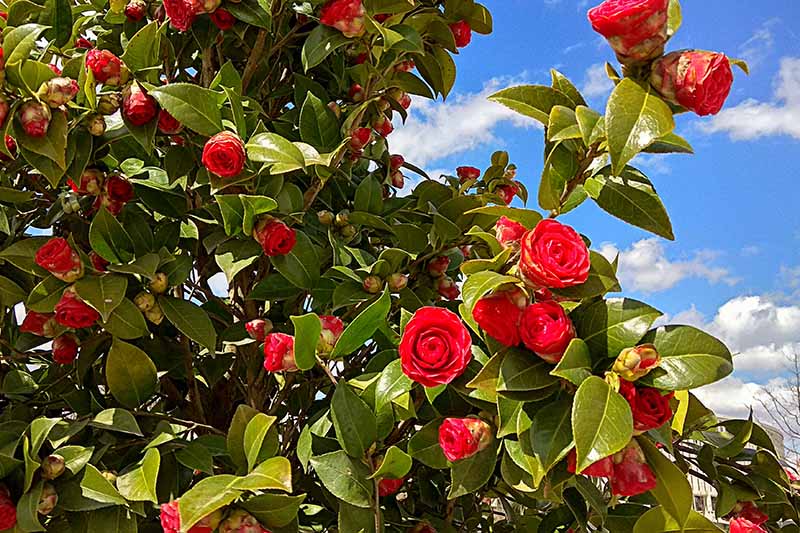
Find the volunteer seedlings and carefully dig them up, because their taproots can go pretty deep depending on how well they’ve taken hold.
You should fill a pot about twice the size of the roots with a planting medium mix that is made up of one part potting soil or compost and one part perlite or coarse silica sand before you move the plant.
You might also want to add some of the things the plant was growing in, like mulch or rotting leaves, to keep the nutrients those things are giving you available after the transplant.
If you want to keep the plants in pots, cut off the end of the taproot with garden shears to help the roots grow in a more fibrous way. If you’ll be transplanting to a new in-ground location, you can skip this step.
Put the seedling in a hole that is about twice as wide and the same depth as the roots at the in-ground site. Lightly backfill the hole and press the soil down with your hands.
Remember that camellias don’t like to be buried too deeply, and that the roots should stay close to the ground.
Make sure not to drown the plants when you water them to help them get used to their new home. Camellias don’t like their roots to be too wet.
If the plants will remain in containers, place them in a location with indirect sunlight or partial shade. Water plants to settle, but be sure that excess water drains off well.
Grafting will make a camellia with the same traits as the parent plant, and it usually takes less time for a new plant to start blooming than other methods.
Grafted camellias can take a while to grow, though, so be ready to wait a few months before you see signs of progress.
From late winter to early spring, pick a rootstock plant with a stem that is half an inch to an inch across. Use sharp pruning shears to cut the trunk off at about four to six inches in length.
The cut should slope at an angle of about 45 degrees from one side to the other. Use a sharp knife to trim the cut so it’s as smooth as possible. Make a two-inch-long vertical slot with the knife on the wider side of the cut.

If you can’t get the knife to make the slit, gently tap it to the right length with a rubber mallet. You don’t want to split the trunk too much or break off a piece, so be careful when you tap.
Next, pick a healthy branch of the camellia plant you want to grow more of and cut a piece about three to six inches long. This cutting, or scion, should have at least one bud and a few leaves present.
Trim the end of the cutting into a wedged angle to fit the slot. Slowly open the hole you made in the rootstock with the knife, then gently slide the scion into the hole.
Grafting wax, such as Treekote, available from Amazon, can be applied if desired.
The bright green part inside the branch just below the bark is called the cambium layer. Make sure it lines up with where the scion and the stem of the rootstock meet. If this layer does not align on both, the graft will fail.
To keep the graft site in place, cover it with black electrical tape, garden cloth, or an elastic band. Put a thick layer of wet, coarse sand around the base of the rootstock to help keep the water in and help the graft heal.
To keep the graft warm and moist, it should be completely enclosed in a cloche or container, like a milk jug with the top cut off or a glass jar. Be sure to seat the container in the damp sand firmly.
Keep the pot in place until the graft gets tough. At that point, the plants will start to grow together. This process can take two to three months. Once the area seems to have healed, slowly take away the pot and keep the grafted plant in the shade while new growth appears.
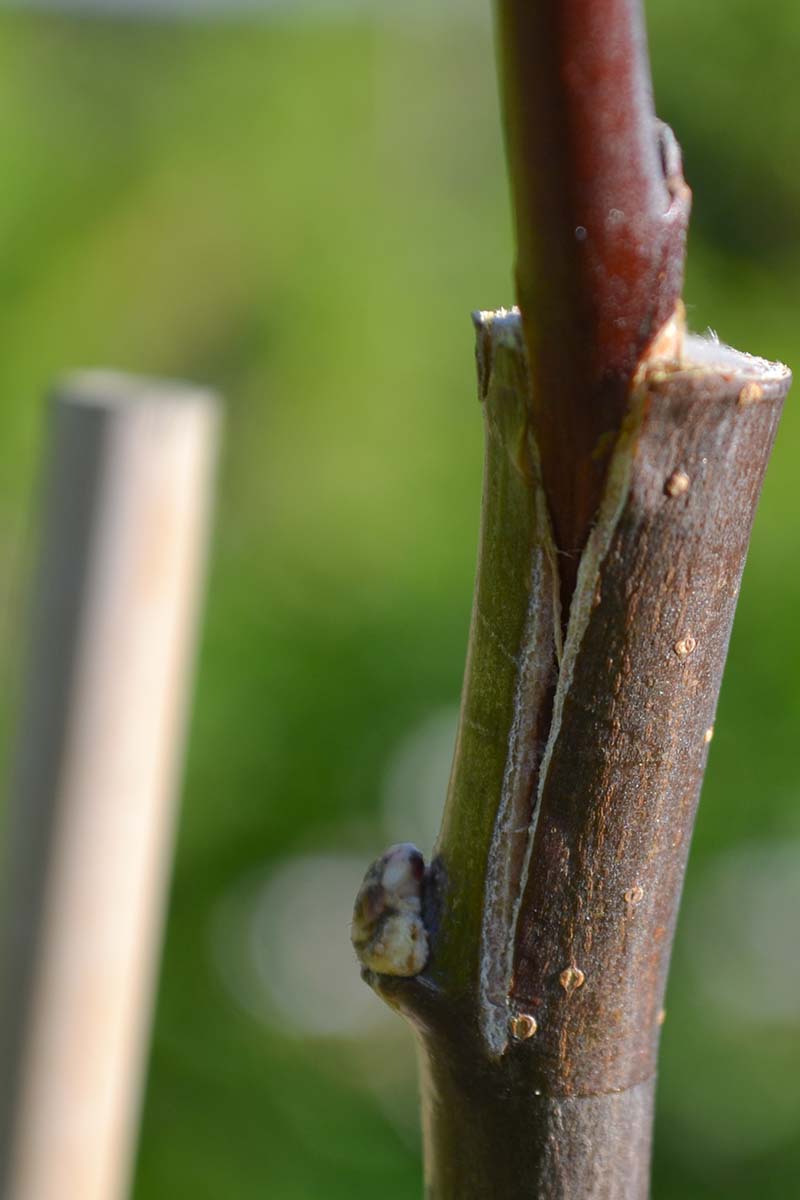
If the graft starts to wilt when the pot is taken off, cover the plant again and try a few more times. It is crucial to protect the plant from intense sunlight until it is more established.
Plants that will stay in their pots can be left alone and put somewhere with some shade or indirect sunlight.
To get ready to plant, dig a hole about twice as wide and deep as the potted plant’s roots.
Start by adding a small mound of soil to the bottom of the hole to keep the roots from being buried too deeply. Place the plant in the hole and backfill with soil, gently compacting it with your hands.
The top of the root system should be at ground level. Water the camellias well to settle them down, but make sure the extra water drains away. They don’t like to sit in water. Poor drainage can lead to root rot.
Camellias can also be propagated easily without taking cuttings first, using a method called layering. This way, you can get a branch to grow roots while it is still connected to the parent plant.
Most of the time, this method works well because the branch will grow roots in the same conditions as the parent tree. The best time of the year for layering is in the spring when plants are actively growing.
Pick a healthy branch that is 18 to 24 inches long and has new growth on it. This will make it easier to root. The branch should be long enough to be bent down to reach the ground.
Carefully cut a slit all the way around the branch with a sharp knife. This is where you will cut it off from the parent plant once it has roots.
Make another slit all the way around about an inch below the first one. Then, cut off the ring of bark between the two.
Scrape off any of the bright green cambium left on the branch at the site. Dust the exposed portion with powdered rooting hormone.
Bend the branch down to the ground and pile up dirt to cover the part that is showing. You can also use wire or rocks to hold the branch in place. This method works best if the branch is lying against soil rather than on top of grass.
Once roots form, the branch can be cut off from the parent plant, the roots can be dug up, and the plant can be moved to its new spot.
Pick a spot that has the same growing conditions as the parent plant, with some shade or indirect sunlight.
Make a hole that is a few inches wider and the same depth as the roots. Add compost or leaf mulch to make more nutrients available. Place the new plant in the hole, being sure not to bury the roots too deeply.
Fill in the rest of the space with soil, then water it to help it settle in. Press the soil down gently with your hands to make it compact.
Prepare a pot that is twice as wide and deep as the root system and add enough potting mix to raise the top of the roots, where they connect to the plant, to soil surface level. This will help you keep the cutting in a pot.
Air layering is essentially the same method as layering described above, but with a couple of key differences.
In the spring, prepare an 18- to 24-inch-long branch in the same way you did with the layering above: pick a healthy branch and cut off a ring of bark from it.
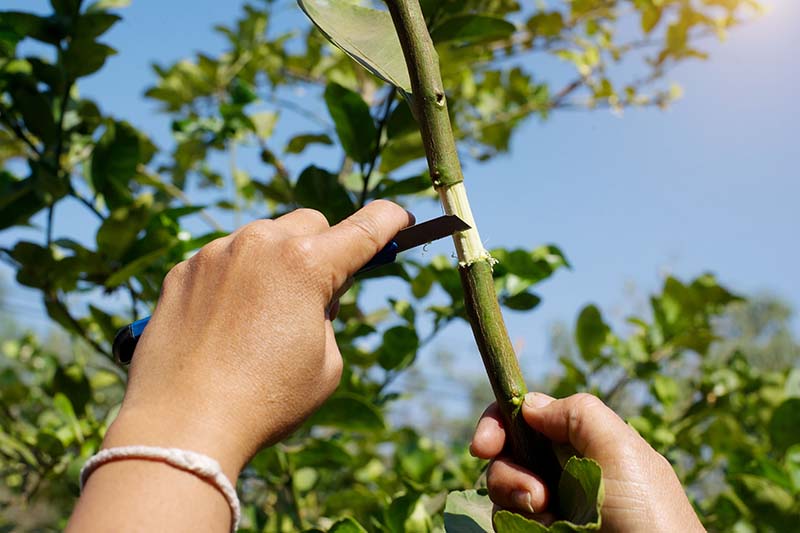
Dust the exposed portion of the branch with powdered rooting hormone.
Wet two handfuls of sphagnum moss and place them on a piece of medium-weight plastic wrap. Wrap the plastic around the branch at the place where the bark has been stripped.
Soil that is wet can be used instead of moss, but it can get messier if you need to open the bag to check for roots and water.
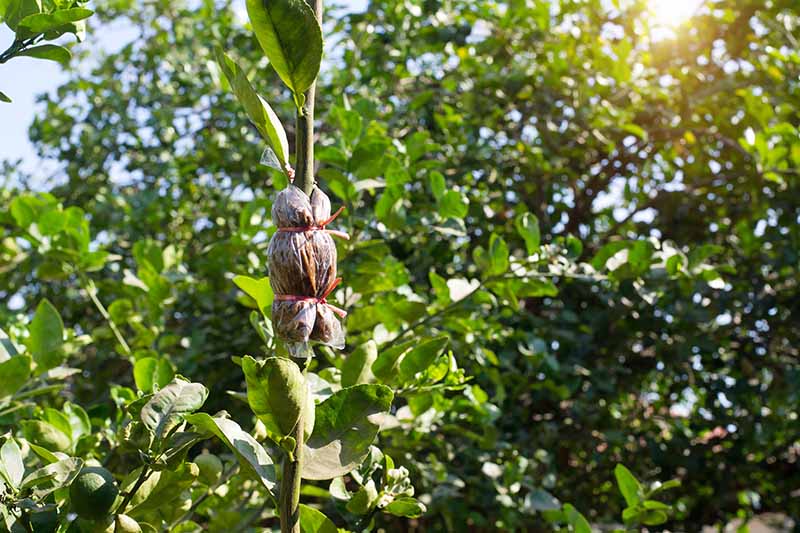
Use black electrical tape to hold the plastic wrap in place, or use two twist ties to hold the ends of the wrap to the branch. Cover with aluminum foil if birds or other wildlife may disturb the site.
Alternatively, you can use a reusable layering device to make the process easier, such as this air layering kit that’s available on Amazon.
About once a week, check to make sure the medium inside the pouch is still moist. Adding a few eye droppers full of water will help keep the soil moist, which is important for the rooting process.
Roots can take up to three months to grow, so check the pouch every so often by gently pressing on it to see if it feels different. Root formation will make the moss or soil inside feel more firm.
You can also take off the foil and look at the moss through the plastic to see if there are any signs of roots breaking through. If you’re using a reusable layering device, do a visual check for roots every few weeks.
Once you can see the roots, you can cut the branch off of the parent and plant it where you want to.
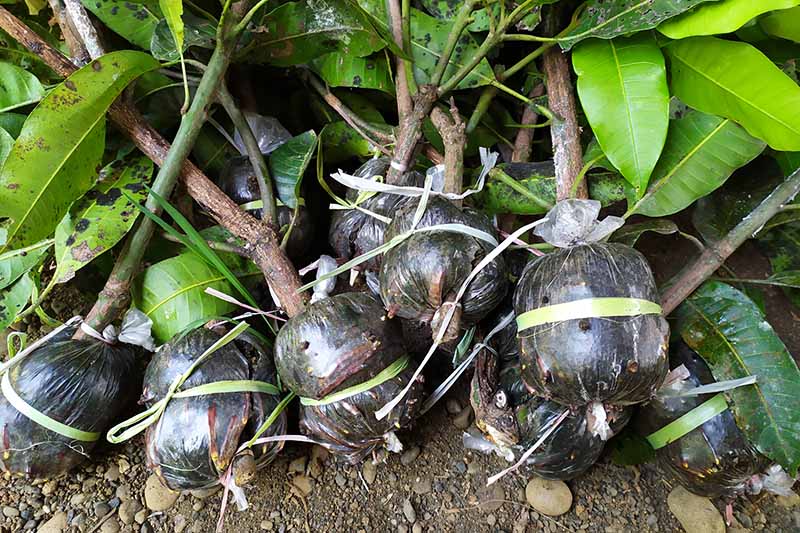
Pick a spot that gets some shade or indirect sunlight, and dig a hole that is twice as wide and deep as the root system.
When you put the plant in the hole, make sure the roots stay close to the ground. Camellias don’t like to be buried too deeply (I can’t stress this enough!)
Once the roots are in place, fill in the empty space with soil around the root system. Use your hands to gently press down on the soil to make it firm and compact. Water well to settle, but be sure not to leave the roots in standing water.
- If you want to grow more camellias, you should only use seeds instead of cloning the parent plant.
- Start with cuttings, layering, air layering, or grafting to get plants that look and act like the parent plant.
- It is very important to keep the right level of moisture in all propagation methods.
- Allow plants enough time to grow strong roots before moving them. This could take anywhere from a few weeks to a few months.
How To Grow Camellias From Cuttings | Camellia Plant Propagation From Cuttings
FAQ
Can I grow a camellia from a cutting?
Can camellias be rooted in water?
What side of the house do you plant a camellia?
How do you sprout camellias?
How do you root a camellia?
Remove any leaves or flowers from the bottom half of the cutting to prevent them from rotting in the water. Rooting hormone: Although not necessary, dipping the cut end of the camellia cutting in a rooting hormone powder can increase the chances of successful rooting.
How do you propagate Camellia cuttings?
gently remove cuttings and plant into individual 8″ pots; fertilize; do not transplant into garden until the pot is filled with roots (note that the bottom cutting did not make roots and has no tip bud) This is my step-by-step process of propagating camellia cuttings.
How do you water a camellia tree?
When watering the camellia cuttings, it is important to use room temperature or slightly warm water. Cold water shock can stress the cuttings and negatively impact their survival. Additionally, it is advisable to water the cuttings from below, rather than pouring water directly onto the leaves or stems.
When should I take Camellia cuttings for rooting?
The best time of year to take camellia cuttings for rooting in water is generally in the spring, right after the plant has finished blooming. This is when the camellia plant is actively growing, and the stems are young and flexible, making them more likely to root successfully.
- The Ultimate Guide to Growing Strawberries in Raised Beds - August 8, 2025
- No-Dig Garden Beds: The Easiest Way to Grow a Beautiful Garden - August 6, 2025
- How to Protect and Preserve Wood for Raised Garden Beds - August 6, 2025

